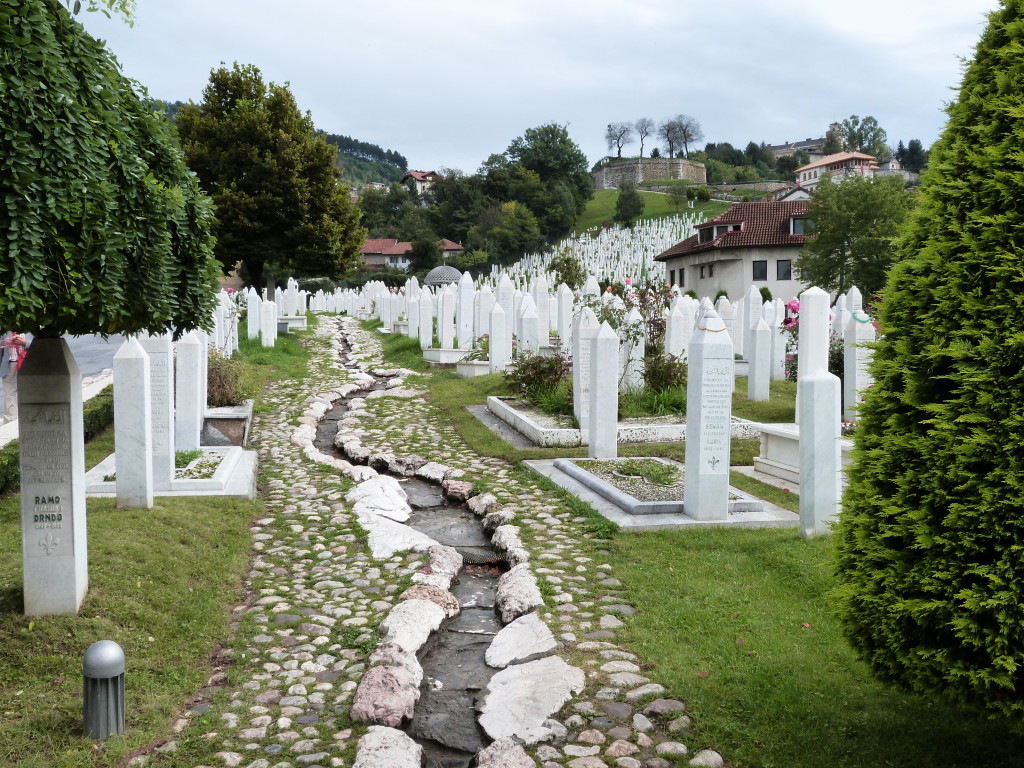There were a lot of reasons I loved Sarajevo – seriously, there were loads – but there is one reason in particular that made me fall in love with the city pretty much instantly: the architecture.
Sarajevo is famed for its tumultuous history and the city’s architecture expresses this beautifully; the Ottomans, the Austro-Hungarians, the Yugoslav wars and the Siege of Sarajevo have all left their mark, making the city one of the most interesting in Europe.
Architecture in Sarajevo: Baščaršija – the Turkish Quarter
The city was officially founded in 1461 by the Ottomans, who ruled the city for around 400 years. Today, their lasting legacy is the neighbourhood known as Baščaršija.
This part of the city was reserved for commerce only, which is why so many of the buildings are only one storey.
Here you’ll find narrow alleyway after narrow alleyway of shops and stalls, a huge market and the beautiful Gazi Husrev-beg Mosque – the most important in the city.
This area is also home to the aptly-named Pigeon Square, which is centred around the Sebilj fountain.
Austro-Hungarian architecture in Sarajevo
But in 1878, after 400+ years of Ottoman rule, Sarajevo became part of Austria-Hungary practically overnight. This was a pretty dramatic change and brought a completely new style of architecture to the the city. (There’s even an ‘East-meets-West’ monument at the point where the Austrian and Ottoman parts of the city meet.)
But despite initial resistance, this era of the city’s history brought a lot of benefits. The Austro-Hungarian Empire brought industry, better infrastructure and new technology to Sarajevo, which became a sort of test-ground for innovations before they were rolled out in Vienna. Thanks to this approach, Sarajevo became the first city in Europe to have a fully electrified tram system in 1885, which is still in use.
The buildings along the river are some of the best examples of Austro-Hungarian architecture in the city, including the University of Sarajevo building.
The Siege of Sarajevo
During the violent and insanely complicated Yugoslav wars that followed the break-up of Yugoslavia, Bosnia & Herzegovina was caught in the crossfire between Serb and Croat forces, who had pretty much agreed to half the country between them (to put it bluntly and simply). This culminated in the Siege of Sarajevo. Lasting from 5 April 1992 to 29 February 1996, the Siege was the longest of a capital city in modern warfare.
Without going into great detail (as I want to discuss the Siege more later), this period had big effect on the city’s appearance, but not necessarily in the way you would think.
For starters, still-bombed-out buildings in Sarajevo are rare. The city has received substantial funding in recent years to rebuild its historic centre and while one or two still remain, you are unlikely to see more than a handful.
Yet reminders are still there: Sarajevo roses can be spotted around the city, though they are not as obvious as you would think. They are the small craters left by exploding shells in the city, which have been filled in with red paint to commemorate the those who were killed by its impact.
Of course, one of the most poignant reminders of the the death toll of the Siege can be seen at the Martyrs’ Cemetery in Kovači, though the people buried there represent just a fraction of the thousands killed during the conflict.
Architecture in Sarajevo: looking to the future
But it’s important to remember the city is still changing – and for the better.
The fully-renovated national library finally reopened this year – it was purposefully bombed during the early stages of the Siege, destroying thousands of irreplaceable works of literature. Thanks to generous EU funding, it was painstaking rebuilt and though we didn’t have time, the interior is supposedly well worth the €2 entrance free.
The distinctive Festina Lente bridge was also opened in 2012, becoming a new symbol of the city. The bridge is found outside the distinctive Academy of Fine Arts, whose students designed it.
What’s more, the city is home to a surprising number of skyscrapers – both old and new, giving it a very cosmopolitan feel, and a somewhat unexpected skyline.
Sarajevo is a beautiful city.
Read more on Bosnia:
The tragedy and potential of Počitelj
Backpacking the Balkans: from Bosnia to Macedonia

